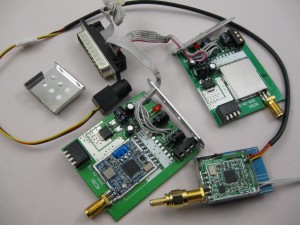Hobbyking 5.8GHz 200mW FPV system
 The “Boscam 5.8Ghz 200mw FPV Wireless AV Tx & Rx Set” from Hobbyking is a great low cost system but is not compliant with the 5.8GHz ISM band here in New Zealand. The “Boscam 5.8Ghz 200mw FPV Wireless AV Tx & Rx Set” from Hobbyking is a great low cost system but is not compliant with the 5.8GHz ISM band here in New Zealand.
The 8 channel frequencies listed by Hobbyking are 5705 5865 5665 5645 5885 5905 5925 5945 MHZ. Note that the second one is a typo and should read 5685, which is not within the allowed 5725-5875 MHz band.
The picture shows my transmitter with heatsink removed (just clips on) and connectors removed with camera and power wiring soldered. And 2 RC305 receivers out of their cases, one with the receiver module cover removed. The receivers have been wired to connect to the diversity controller. Ignore the wiring soldered to the boards, we’re only interested in the smaller RF modules.
The antenna plug attached to the transmitter is a 50-ohm dummy load. Don’t run the transmitter without a load or antenna connected as you may damage it.
Note: You can run the receiver at more than 5V DC supply. It has an internal regulator and will cope with 12V or a 3-cell Lipo, but will get warm. |
HobbyKing now have the Skyzone 5823 5.8 GHz 32 ch 200 mW vid Tx :
http://www.hobbyking.com/hobbyking/store/uh_viewitem.asp?idproduct=63114
and looking at the published specs I see that of these 32 ch available, 23 ch are within our legal ISM range. Plus in keeping with the name it’s smaller than the ‘regular’ TS 351 and weighs in at only 8g but still pumps out 200 mW
andy
Yes these are quite nice, and small.
Unfortunately, because they are capable of transmitting out of band on a few channels, they are technically not allowed.
I have one here but haven’t had a good play with it yet. From memory, one or two of the channel select dip switches swap banks/bands. If these could be permanently fixed to select 8 channels within our ISM band, you’d possibly be OK; who can say for sure when regulations are involved 🙂